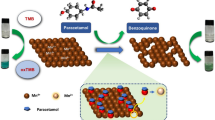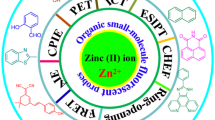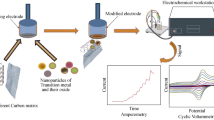Abstract
A new bi-functional chemosensor 1 based on 3,5-dichlorosalicylaldehyde and 2-(methylthio)aniline has been synthesized. It can detect Cu2+ with a color change from pale yellow to dark yellow in aqueous solution. The selective mechanism of 1 for Cu2+ was proposed to be the enhancement of the intramolecular charge transfer (ICT) band, which was explained by theoretical calculations. The sensor 1 could be used to detect and quantify Cu2+ in water samples. In addition, the sensor 1 displayed “turn-on” fluorescence response only to Zn2+, based on an effect of chelation-enhanced fluorescence (CHEF). Therefore, 1 can serve as a ‘single sensor for two different targets’ with dual modes.











Similar content being viewed by others
References
Kim JH, Noh JY, Hwang IH, Kang J, Kim J, Kim C (2013) An anthracene-based fluorescent chemosensor for Zn2+. Tetrahedron Lett 54:2415–2418
Wang W, Fu A, You J, Gao G, Lan J, Chen L (2010) Squaraine-based colorimetric and fluorescent sensors for Cu2+-specific detection and fluorescence imaging in living cells. Tetrahedron 66:3695–3701
Mahapatra AK, Hazra G, Das NK, Goswami S (2011) A highly selective triphenylamine-based indolylmethane derivatives as colorimetric and turn-off fluorimetric sensor toward Cu2+ detection by deprotonation of secondary amines. Sensors Actuators B Chem 156:456–462
Kaur P, Kaur S, Singh K (2009) Colorimetric detection of cyanide in water using a highly selective Cu2+ chemosensor. Inorg Chem Commun 12:978–981
Chen X, Jou MJ, Lee H, Kou S, Lim J, Nam S-W, Park S, Kim K-M, Yoon J (2009) New fluorescent and colorimetric chemosensors bearing rhodamine and binaphthyl groups for the detection of Cu2+. Sensors Actuators B Chem 137:597–602
Yin S, Leen V, Van Snick S, Boens N, Dehaen W (2010) A highly sensitive, selective, colorimetric and near-infrared fluorescent turn-on chemosensor for Cu2+ based on BODIPY. Chem Commun (Camb) 46:6329–6331
Yu F, Zhang W, Li P, Xing Y, Tong L, Ma J, Tang B (2009) Cu2+-selective naked-eye and fluorescent probe: its crystal structure and application in bioimaging. Analyst 134:1826–1833
Liu J, Lu Y (2007) Colorimetric Cu2+ detection with a ligation DNAzyme and nanoparticles. Chem Commun 4872
Jung HS, Kwon PS, Lee JW, Kim JI, Hong CS, Kim JW, Yan S, Lee JY, Lee JH, Joo T, Kim JS (2009) Coumarin-derived Cu2+-selective fluorescence sensor: synthesis, mechanisms, and applications in living cells. J Am Chem Soc 131:2008–2012
Li Y, Zhang X, Zhu B, Xue J, Zhu Z, Tan W (2011) A simple but highly sensitive and selective colorimetric and fluorescent probe for Cu2+ in aqueous media. Analyst 136:1124–1128
Yu M-M, Li Z-X, Wei L-H, Wei D-H, Tang M-S (2008) A 1,8-naphthyridine-based fluorescent chemodosimeter for the rapid detection of Zn2+ and Cu2+. Org Lett 10:5115–5118
Rurack K (2001) Flipping the light switch “ON” – the design of sensor molecules that show cation-induced fluorescence enhancement with heavy and transition metal ions. Spectrochim Acta A Mol Biomol Spectrosc 57:2161–2195
Kim MS, Kim KS, Yang SO, Kim KW (2009) Pentalogy of Cantrell in a neonate: a case report. J Korean Soc Radiol 61:341
Huang X, Guo Z, Zhu W, Xie Y, Tian H (2008) A colorimetric and fluorescent turn-on sensor for pyrophosphate anion based on a dicyanomethylene-4H-chromene framework. Chem Commun (Camb) 5143–5145.
Mu H, Gong R, Ma Q, Sun Y, Fu E (2007) A novel colorimetric and fluorescent chemosensor: synthesis and selective detection for Cu2+ and Hg2+. Tetrahedron Lett 48:5525–5529
Goswami S, Sen D, Das NK (2010) A new highly selective, ratiometric and colorimetric fluorescence sensor for Cu2+ with a remarkable red shift in absorption and emission spectra based on internal charge transfer. Org Lett 12:856–859
Song EJ, Park GJ, Lee JJ, Lee S, Noh I, Kim Y, Kim SJ, Kim C, Harrison RG (2015) A fluorescence sensor for Zn2+ that also acts as a visible sensor for Co2+ and Cu2+. Sensors Actuators B Chem 213:268–275
Noh JY, Park GJ, Na YJ, Jo HY, Lee SA, Kim C (2014) A colorimetric “naked-eye” Cu(II) chemosensor and pH indicator in 100 % aqueous solution. Dalton Trans 43:5652–5656
Gunnlaugsson T, Leonard JP, Murray NS (2004) Highly selective colorimetric naked eye Cu(II) detection using an azobenzene chemosensor. Org Lett 6:1557–1560
Kim KB, Kim H, Song EJ, Kim S, Noh I, Kim C (2013) A cap-type Schiff base acting as a fluorescence sensor for zinc(II) and a colorimetric sensor for iron(II), copper(II), and zinc(II) in aqueous media. Dalton Trans 42:16569–16577
Kundu A, Hariharan PS, Prabakaran K, Anthony SP (2015) Synthesis of new colori/fluorimetric chemosensor for selective sensing of biologically important Fe3+, Cu2+ and Zn2+ metal ions. Spectrochim Acta A Mol Biomol Spectrosc 151:426–431
Chen C, Men G, Bu W, Liang C, Sun H, Jiang S (2015) A colorimetric and fluorescent probe for multiple transition metal ions (Cu2+, Zn2+ and Ni2+): fast response and high selectivity. Sensors Actuators B Chem 220:463–471
Tang L, Cai M, Huang Z, Zhong K, Hou S (2013) Rapid and highly selective relay recognition of Cu(II) and sulfide ions by a simple benzimidazole-based fluorescent sensor in water. Sensors Actuators B Chem 185:188–194
Xie XM, Smart TG (1991) A physiological role for endogenous zinc in rat hippocampal synaptic neurotransmission. Nature 349:521–524
Jiang PJ, Guo ZJ (2004) Fluorescent detection of zinc in biological systems: recent development on the design of chemosensors and biosensors. Coord Chem Rev 248:205–229
Zalewski PD, Forbes IJ, Betts WH (1993) Correlation of apoptosis with change in intracellular labile Zn(II) using zinquin [(2-methyl-8-p-toluenesulphonamido-6-quinolyloxy)acetic acid], a new specific fluorescent probe for Zn(II). Biochem J 296(Pt 2):403–408
Na YJ, Hwang IH, Jo HY, Lee SA, Park GJ, Kim C (2013) Fluorescent chemosensor based-on the combination of julolidine and furan for selective detection of zinc ion. Inorg Chem Commun 35:342–345
Weiss JH, Sensi SL, Koh JY (2000) Zn2+: a novel ionic mediator of neural injury in brain disease. Trends Pharmacol Sci 21:395–401
Bitanihirwe BKY, Cunningham MG (2009) Zinc: the brain’s dark horse. Synapse 63:1029–1049
Lin H-Y, Cheng P-Y, Wan C-F, Wu A-T (2012) A turn-on and reversible fluorescence sensor for zinc ion. Analyst 137:4415–4417
Frederickson CJ (1989) Neurobiology of zinc and zinc-containing neurons. Int Rev Neurobiol 31:145–238
Parkesh R, Clive Lee T, Gunnlaugsson T (2007) Highly selective 4-amino-1,8-naphthalimide based fluorescent photoinduced electron transfer (PET) chemosensors for Zn(II) under physiological pH conditions. Org Biomol Chem 5:310–317
Park MS, Swamy KMK, Lee YJ, Lee HN, Jang YJ, Moon YH, Yoon J (2006) A new acridine derivative as a fluorescent chemosensor for zinc ions in an 100 % aqueous solution: a comparison of binding property with anthracene derivative. Tetrahedron Lett 47:8129–8132
Cai Y, Meng X, Wang S, Zhu M, Pan Z, Guo QX (2013) A quinoline based fluorescent probe that can distinguish zinc(II) from cadmium(II) in water. Tetrahedron Lett 54:1125–1128
Cuajungco MP, Lees GJ (1997) Zinc metabolism in the brain: relevance to human neurodegenerative disorders. Neurobiol Dis 4:137–169
Choi DW, Koh JY (2003) Zinc and brain injury. Annu Rev Neurosci 21:347–375
Bush AI (2003) Alzheimer Dis Assoc Disord 17:147–150
Cuajungco MP, Lees GJ (1997) Zinc and Alzheimer’s disease: is there a direct link? Brain Res Rev 23:219–236
Takeda A (2001) Zinc homeostasis and functions of zinc in the brain. Biometals 14:343–351
Kim JH, Hwang IH, Jang SP, Kang J, Kim S, Noh I, Kim Y, Kim C, Harrison RG (2013) Zinc sensors with lower binding affinities for cellular imaging. Dalton Trans 42:5500–5507
Lee HG, Lee JH, Jang SP, Hwang IH, Kim S-J, Kim Y, Kim C, Harrison RG (2013) Zinc selective chemosensors based on the flexible dipicolylamine and quinoline. Inorg Chim Acta 394:542–551
Lee HG, Lee JH, Jang SP, Park HM, Kim S-J, Kim Y, Kim C, Harrison RG (2011) Zinc selective chemosensor based on pyridyl-amide fluorescence. Tetrahedron 67:8073–8078
Rajabi Khorrami A, Fakhari AR, Shamsipur M, Naeimi H (2009) Pre-concentration of ultra trace amounts of copper, zinc, cobalt and nickel in environmental water samples using modified C18 extraction disks and determination by inductively coupled plasma–optical emission spectrometry. Int J Environ Anal Chem 89:319–329
Ghaedi M, Ahmadi F, Shokrollahi A (2007) Simultaneous preconcentration and determination of copper, nickel, cobalt and lead ions content by flame atomic absorption spectrometry. J Hazard Mater 142:272–278
Rao KS, Balaji T, Rao TP, Babu Y, Naidu GRK (2002) Determination of iron, cobalt, nickel, manganese, zinc, copper, cadmium and lead in human hair by inductively coupled plasma- atomic emission spectrometry. Spectrochim Acta B At Spectrosc 57:1333–1338
Sturgeon RE, Berman SS, Desaulniers A, Russell DS (1979) Determination of iron, manganese, and zinc in seawater by graphite furnace atomic absorption spectrometry. Anal Chem 51:2364–2369
GULABOSKI R, MIRESKI V, SCHOLZ F (2002) An electrochemical method for determination of the standard Gibbs energy of anion transfer between water and n-octanol. Electrochem Commun 4:277–283
Park GJ, Na YJ, Jo HY, Lee SA, Kim AR, Noh I, Kim C (2014) A single chemosensor for multiple analytes: fluorogenic detection of Zn2+ and OAc− ions in aqueous solution, and an application to bioimaging. New J Chem 38:2587
Wang J, Lin W, Li W (2012) Single fluorescent probe displays a distinct response to Zn2+ and Cd2+. Chemistry 18:13629–13632
Duong TQ, Kim JS (2010) Fluoro- and chromogenic chemodosimeters for heavy metal ion detection in solution and biospecimens. Chem Rev 110:6280–6301
Liu X, Zhang N, Zhou J, Chang T, Fang C, Shangguan D (2013) A turn-on fluorescent sensor for zinc and cadmium ions based on perylene tetracarboxylic diimide. Analyst 138:901–906
Hu Y, Liu Y, Kim G, Jun EJ, Swamy KMK, Kim Y, Kim S-J, Yoon J (2015) Pyrene based fluorescent probes for detecting endogenous zinc ions in live cells. Dyes Pigments 113:372–377
Guo Z, Kim G-H, Yoon J, Shin I (2014) Synthesis of a highly Zn2+-selective cyanine-based probe and its use for tracing endogenous zinc ions in cells and organisms. Nat Protoc 9:1245–1254
Choi JY, Kim D, Yoon J (2013) A highly selective “turn-on” fluorescent chemosensor based on hydroxy pyrene–hydrazone derivative for Zn2+. Dyes Pigments 96:176–179
Liu Z, Zhang C, Chen Y, Qian F, Bai Y, He W, Guo Z (2014) In vivo ratiometric Zn2+ imaging in zebrafish larvae using a new visible light excitable fluorescent sensor. Chem Commun 50:1253–1255
Zhang C, Liu Z, Li Y, He W, Gao X, Guo Z (2013) In vitro and in vivo imaging application of a 1,8-naphthalimide-derived Zn2+ fluorescent sensor with nuclear envelope penetrability. Chem Commun (Camb) 49:11430–11432
Jiang Q, Guo Z, Zhao Y, Wang F, Mao L (2015) In vivo fluorescence sensing of the salicylate-induced change of zinc ion concentration in the auditory cortex of rat brain. Analyst 140:197–203
Becke AD (1993) Density-functional thermochemistry.III. The role of exact exchange. J Chem Phys 98:5648
Lee C, Yang W, Parr RG (1988) Development of the Colle-Salvetti correlation-energy formula into a functional of the electron density. Phys Rev B 37:785–789
Yucel RM, He Y, Zaslavsky AM (2011) Gaussian-based routines to impute categorical variables in health surveys. Stat Med 30:3447–3460
Hariharan PC, Pople JA (1973) The influence of polarization functions on molecular orbital hydrogenation energies. Theor Chim Acta 28:213–222
Francl MM (1982) Self-consistent molecular orbital methods. XXIII. A polarization-type basis set for second-row elements. J Chem Phys 77:3654
Wadt WR, Hay PJ (1985) Ab initio effective core potentials for molecular calculations. Potentials for main group elements Na to Bi. J Chem Phys 82:284–298
Hay PJ, Wadt WR (1985) Ab initio effective core potentials for molecular calculations. Potentials for the transition metal atoms Sc to Hg. J Chem Phys 82:270
Barone V, Cossi M (1998) Quantum calculation of molecular energies and energy gradients in solution by a conductor solvent model. J Phys Chem A 102:1995–2001
Cossi M, Barone V (2001) Time-dependent density functional theory for molecules in liquid solutions. J Chem Phys 115:4708–4717
O & apos; Boyle NM, Tenderholt AL, Langner KM (2008) Cclib: a library for package-independent computational chemistry algorithms. J Comput Chem 29:839–845.
Goswami S, Das AK, Maity S (2013) “PET” vs. “push-pull” induced ICT: a remarkable coumarinyl-appended pyrimidine based naked eye colorimetric and fluorimetric sensor for the detection of Hg2+ ions in aqueous media with test trips. Dalton Trans 42:16259–16263
Job P (1928) Formation and stability of inorganic complexes in solution. Ann Chim 9:113–203
Benesi HA, Hildebrand JH (1949) A spectrophotometric investigation of the interaction of iodine with aromatic hydrocarbons. J Am Chem Soc 71:2703–2707.
Wu S-P, Du K-J, Sung Y-M (2010) Colorimetric sensing of Cu(II): cu(II) induced deprotonation of an amide responsible for color changes. Dalton Trans 39:4363–4368
Xiang Y, Tong A, Jin P, Ju Y (2006) New fluorescent rhodamine hydrazone chemosensor for Cu(II) with high selectivity and sensitivity. Org Lett 8:2863–2866
Wu GH, Wang DX, Wu DY, Gao Y, Wang ZQ (2009) Highly sensitive optical chemosensor for the detection of Cu2+ using a rhodamine B spirolatam. J Chem Sci 121:543–548
Tsui Y-K, Devaraj S, Yen Y-P (2012) Azo dyes featuring with nitrobenzoxadiazole (NBD) unit: a new selective chromogenic and fluorogenic sensor for cyanide ion. Sensors Actuators B Chem 161:510–519
Gordon B, Callan P, Vickers C (2008) WHO guidelines for drinking-water quality. WHO Chron 38:564
Park GJ, Lee JJ, You GR, Nguyen LT, Noh I, Kim C (2016) A dual chemosensor for Zn2+ and Co2+ in aqueous media and living cells: experimental and theoretical studies. Sensors Actuators B Chem 223:509–519
Ma Y, Wang F, Kambam S, Chen X (2013) A quinoline-based fluorescent chemosensor for distinguishing cadmium from zinc ions using cysteine as an auxiliary reagent. Sensors Actuators B Chem 188:1116–1122
Lim NC, Schuster JV, Porto MC, Tanudra MA, Yao L, Freake HC, Brückner C (2005) Coumarin-based chemosensors for zinc(II): toward the determination of the design algorithm for CHEF-type and ratiometric probes. Inorg Chem 44:2018–2030
Zhou Y, Li ZX, Zang SQ, Zhu YY, Zhang HY, Hou HW, Mak TCW (2012) A novel sensitive turn-on fluorescent Zn2+ chemosensor based on an easy to prepare C 3-symmetric schiff-base derivative in 100 % aqueous solution. Org Lett 14:1214–1217
Hsieh WH, Wan CF, Liao DJ, Wu AT (2012) A turn-on Schiff base fluorescence sensor for zinc ion. Tetrahedron Lett 53:5848–5851
Acknowledgments
Basic Science Research Program through the National Research Foundation of Korea (NRF) funded by the Ministry of Education, Science and Technology (NRF-2014R1A2A1A11051794 and NRF-2015R1A2A2A09001301) is gratefully acknowledged. We thank Nano-Inorganic Laboratory, Department of Nano & Bio Chemistry, Kookmin University to access the Gaussian 03 program packages.
Author information
Authors and Affiliations
Corresponding author
Electronic supplementary material
ESM 1
(DOCX 3298 kb)
Rights and permissions
About this article
Cite this article
Kim, M.S., Jo, T.G., Ahn, H.M. et al. A Colorimetric and Fluorescent Chemosensor for the Selective Detection of Cu2+ and Zn2+ Ions. J Fluoresc 27, 357–367 (2017). https://doi.org/10.1007/s10895-016-1964-3
Received:
Accepted:
Published:
Issue Date:
DOI: https://doi.org/10.1007/s10895-016-1964-3




